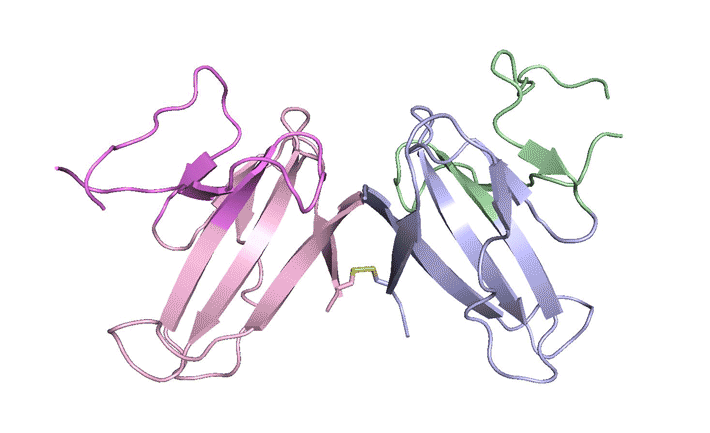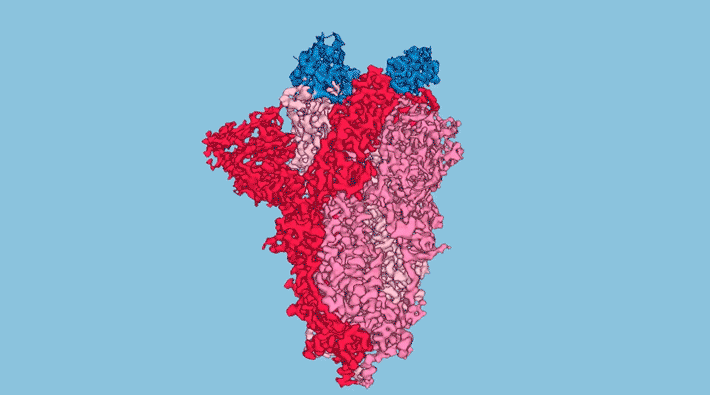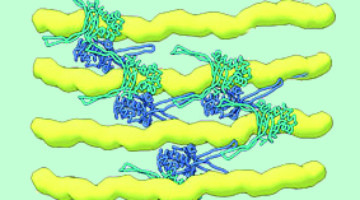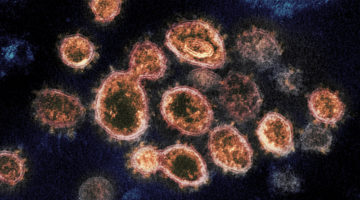Early in the COVID-19 pandemic, it was quickly established that the receptor binding domain (RBD) of the SARS-CoV-2 spike protein is a prime target for neutralizing antibodies. Now, scientists have found a second region of the spike protein that is targeted by dozens of antibodies, some of which exhibit ultrapotent neutralizing activity. Read more »
Guiding Target Selection for COVID-19 Antibody Therapeutics
Protein-structure studies helped demonstrate that the primary target of antibody-based COVID-19 immunity is the part of the virus’s spike protein that can most easily mutate. The work anticipated the rise of SARS-CoV-2 variants and guides the selection of antibody therapeutics that are likely to be more resistant to immune escape. Read more »![]()
![]()
Mystery Protein Helps COVID–19 Avoid Immunity
Using the Advanced Light Source (ALS), researchers solved the structure of ORF8, a protein specific to SARS-CoV-2. Understanding the structure of ORF8 opens the door to therapy studies targeting SARS-CoV-2, the virus responsible for causing COVID-19. Read more »![]()
![]()
Inhalable COVID-19 Protection via Synthetic Nanobodies
Protein structures obtained in part at the ALS helped researchers to increase the potency of simplified antibodies (nanobodies) designed to neutralize SARS-CoV-2. Stable enough to be used in inhalers or nasal sprays, the nanobodies offer a new option, aside from injected vaccines, for COVID-19 prevention and treatment. Read more »![]()
![]()
Experimental Drug Targets HIV in a Novel Way
Researchers from Gilead Sciences Inc. solved the structure of an experimental HIV drug bound to a novel target: the capsid protein that forms a shield around the viral RNA. The work could lead to a long-lasting HIV treatment that overcomes the problem of drug resistance and avoids the need for burdensome daily pill-taking. Read more »![]()
![]()
How Proteins Remodel DNA in Bacteria under Stress
Multiscale, multimodal visualization techniques at the ALS enabled researchers to clarify how proteins remodel bacterial DNA in response to stressful environments. The discovery could lead to new strategies for controlling microbial behavior and, eventually, new ways to fight bacterial infections. Read more »![]()
![]()
Rotavirus VP3 Is a Multifunctional Capping Machine
Rotavirus, a major cause of infantile gastroenteritis, is responsible for the deaths of about 200,000 children per year. Although vaccines are available, the virus still circulates, and a fuller understanding of the viral structures is needed. Here, scientists investigate the structure and function of the last unsolved rotavirus structural protein. Read more »
Antibody from SARS Survivor Neutralizes SARS-CoV-2
Using structural data from the ALS and cryo-electron microscopy, researchers have characterized how an antibody binds to and neutralizes SARS-CoV-2. This work provides the basis for therapeutic and vaccine development for the SARS-CoV-2 virus, which is responsible for the COVID-19 pandemic. Read more »![]()
![]()
Assembly Lines for Designer Bioactive Compounds
Researchers successfully bioengineered changes to a molecular “assembly line” for bioactive compounds, based in part on insights gained from small-angle x-ray scattering at the ALS. The ability to re-engineer these assembly lines could improve their performance and facilitate the synthesis of new medically useful compounds. Read more »![]()
![]()
Molecular Handle Enables Viral Attack on Joint Cells
A collaboration of university and industry researchers used x-ray crystallography to investigate how the chikungunya virus, which can cause debilitating joint pain, engages a receptor protein found on the surfaces of joint cells. The work provides a path forward in the fight against a family of viruses that can result in acute and chronic arthritis. Read more »![]()
![]()









